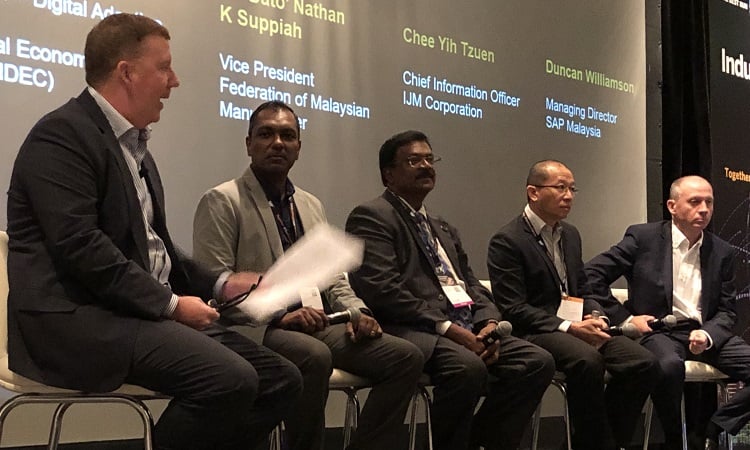Muhundhan Kamarapullai, the Deputy Director of Digital Adoption Ecosystem at Malaysia Digital Economy Corporation (MDEC), believes that the adoption of Industry 4.0 nationwide is not something that government alone can do, but rather has to come from a concerted effort from all the ecosystem players.
“It’s pretty interesting to see how this transformative shift into Industry 4.0 has changed the landscape from the economic, social, and environmental perspectives. In this respect, every government would want to see how it can become more competitive. Based on Malaysia’s Industry4WRD policy, you’ll see that it’s not predominantly coming from the government, it’s actually looking at it from a public-private partnership.”
Muhundhan said this during a panel discussion at the Asian Innovators Summit 2019 organised by SAP in Kuala Lumpur and held earlier last month. Moderated by Jeff Majestic, Senior Director of Digital Supply Chain at SAP (Asia Pacific & Japan), fellow panellists included Dato’ Nathan K Suppiah, VP at Federation of Malaysian Manufacturers (FMM), Chee Yih Tzuen, Chief Information Officer at IJM Corporation and 20-year-old SAP veteran Duncan Williamson.
He added that the Industry 4.0 transformation has already happened.
“Malaysia predominantly being a manufacturing country, we’ve done pretty well, but in order for us to move forward as mentioned by Vijay (Motwani, Chief Operating Officer for SAP Southeast Asia) just now, we can’t just look at how we’ve been doing things. And for that, government needs to take a proactive role, but at the same time I think that government also realises that it cannot be leading this; it has to create that ecosystem, take a step back, and allow the industry to move forward,” said Muhundhan. Vijay had defined Industry 4.0 as the automation of manufacturing processes and data exchanges throughout these processes using technologies such as cyber-physical devices, Internet of Things, machine learning, artificial intelligence, big data analytics, and mobile and cloud computing, in order to boost productivity beyond the levels seen in the previous three Industrial Revolutions.
Meanwhile, IJM Corporation’s Chee acknowledges that, from a Group perspective, IJM realised that it needed to do something different.
“If you look at the rate of digitalisation, construction is lower than manufacturing. While IJM does have manufacturing operations, in general the technical majority is low. All of you want cheaper houses; tolls to be abolished, and bigger highways, so we need to find a way to meet consumer demand.
“We have traditionally been operating in a lot of siloes; it’s not just siloes at the business unit level – our property arm has siloes within that division, so we have to try and overcome all of this. The first thing that we have done is to remove those siloes, and we’ve made an investment in SAP to ensure that we have some transparency into what’s happening and have a standard way in which we manage the business.”
Going forward, what Chee wishes to see happen is a collapsing of all the operation technologies in all of IJM’s business units.
“Whether it’s those people operating the cranes at our ports; the smart cities at our property division; the toll collectors at our tolls; we want to be able to move that data back to our backend so that we have a consolidated view of what’s happening in real-time across our businesses. The idea behind that is we want to have access to the data to make sure that we have ways in which we can monetise all that’s happening here.”
Chee states that there is a fundamental shift in the way IJM is operating on the construction and property side.
“We now have to meet the demand of reduced prices amidst higher costs; therefore, the industry’s changing. We need to change the way we mix concrete; the way we build houses. So this is moving to things like quick fabrication, Industrialised Building Systems (IBS), modelling of what we want to develop.”
Speaking from the manufacturers’ perspective, FMM’s Dato’ Suppiah noted that Malaysia originally started out as an agricultural economy, and only in the 1980s was there an influx of multinational companies coming from other parts of the world such as the US, Japan, Europe, and Australia, amongst others.
“In that respect, automation and modernisation will take some time. A lot of preparatory work is in progress. There are financial factors involved as well. The awareness level is very high amongst manufacturers; they realise they must embrace Industry 4.0. it’s a question of when and how, what kind of obstacles are going to be faced, will there be sharing of company information; these kinds of preliminary challenges are there.”
 Muhundhan (pic) notes that there are 4 main issues faced by a number of organisations.
Muhundhan (pic) notes that there are 4 main issues faced by a number of organisations.
“Firstly, technology is nothing new. The mindset is changing from IT to digital. IT is what we all have; the legacy systems. Digital is something where you can create and build new sources of growth and new opportunities. So how can this Industry 4.0 create something new for you? It has to be some sort of structured approach that you need to take.
“Think big, start small, and scale fast. Have that mindset of thinking ‘Digital is going to help me build something, but how do I start it small enough so that I don’t invest too much, and when I figure out the ROI – whether it’s in improving productivity, creating new sources of growth – how can I take it and scale it as fast as I can?’
“The second part is that most of the companies, maybe even in this region, probably would not have a digital strategy. You may have all the technologies, but you may not have a digital strategy. Without a digital strategy, what happens is you don’t have funds allocated for you to try out new things, and that is a big hindrance for a lot of companies.
“The third part is the talent. There is a lot of work being done in Malaysia; if you look at some of the TVET providers, they’re doing fantastic stuff; they’re working with some German companies in producing those kinds of capabilities. Two issues with regards to talent; do I have the right people, and can I attract the Millennials to come and join my company?
“The last part is that the technology is so fast-paced that things look super-complicated. In the minds of CEOs, especially the manufacturers, they think that it’s so dynamic that maybe they should just wait and see. Unfortunately, with digital disruption, it doesn’t knock on the door; it has already hit you. When the FinTech companies came, they didn’t tell the banking sector that they were going to take away 30% of revenues.”
SAP providing context, operating at a higher level to AI
Meanwhile, SAP’s Williamson said that, with Industry 4.0, production, logistics, and customer services are aligning themselves with digital technology: “By connecting all the components, organisations can build an end-to-end supply and value chain. This brings flexibility and leaner processes, and makes companies more agile.”
“Artificial intelligence is taking on increasingly complex tasks and can further optimise production, thus accelerating processes, cutting the number of errors, and reducing costs. Ultimately, modern software makes the devices and machines themselves smarter, so they can function independently within the framework of a company’s operations,” said Williamson. “In smart manufacturing, machinery, plants, and tools connect through a platform, enabling them to communicate with each other. The platform software can, for example, analyze the data collected and therefore predict malfunctions before they happen or adapt processes to changed production conditions.”
Williamson then emphasised that SAP’s value proposition is that it provides the context.
“If I have a customer order, SAP can track the customer order from time you receive order right through to the time you deliver the order. What you’re able to do is not only tell the customer when he’s receives it, that he got what he asked for, but to tell him the process it went through. Exactly how it was checked, how it was re-rerouted. You can go into that level of detail.”
“Robotics is able to take that information and execute on the instructions. What SAP does is it operates at the level above that and it collects all the information and then gives context. So the context travels, all the way through the process, as oppose to robotics which is simply creating and doing what they’re told,” explained Williamson.
“This then leads to customisation. For example, if making food, I can print a label and state where it came from, which country it was produced in, how it was produced: Was it manually, was it sustainably grown, was it genetically modified? As I mentioned earlier, SAP operates at a higher level to AI,” he concluded.


